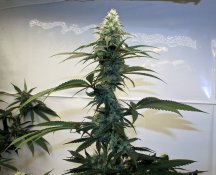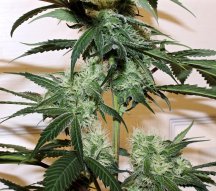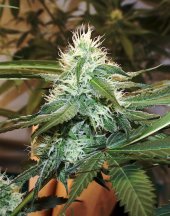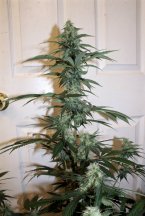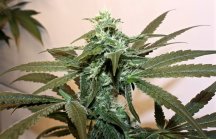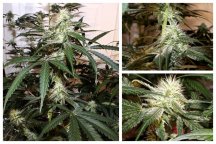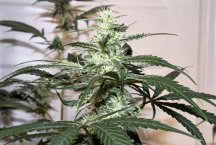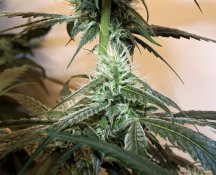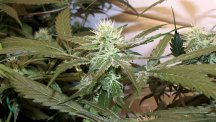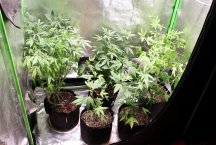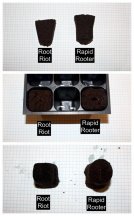Schwaggy P's Random Stuff
- Thread starter Schwaggy P
- Start date
View attachment 2734
I decided to try out Terpinator for a current run and have found that it really improves the intensity of the smell. It is something that I would like to incorporate into my nutrient regimen. Unfortunately, the required dosage and relatively steep price has me hesitant to commit.
The label reads: Soluble Potash (K2O)……4.0%, Derived from Potassium Sulfate
Add 5-10mL/gal in veg
Add 10-30mL/gal in flower
So I have decided to try to replicate this additive by mixing my own Potassium Sulfate solution and testing it on a run of the same cut that has responded well to Terpinator.
I have done some calculations and found that in order to create the same concentration of Soluble Potash derived from Potassium Sulfate, I will need to add 300g of Potassium Sulfate per gallon of water (The math is included below).
‼PLEASE NOTE: I have yet to apply this to plants. I will be testing this mixture and making notes of any issues/successes and suggestions for possible further adjustment. Do not try this at home (yet). Neither Schwaggy P, nor any Schwaggy P subsidiaries are responsible for any grower attempting this recipe or the results thereof.
MATERIALS
View attachment 2735
One gallon distilled water
Potassium Sulfate
Container for the solution
Scale
Gloves
Flask (optional for smaller mixed solutions)
PROCEDURE
View attachment 2736
Wearing gloves, mass the Potassium Sulfate (pic 1).
Make sure to weigh out amounts that your scale can handle. If your scale cannot handle 300g measurements, mass several “batches” of Potassium Sulfate to equal 300g
Carefully transfer the Potassium Sulfate into your container (pic 2).
A funnel may be helpful
Pour about half of the distilled water into the container (pic3).
Filling only half way allows room for you to shake the solution and assist the dissolving process
Shake the container vigorously (pic 4), then fill the container with the remaining half of distilled water. At this point you have a one-gallon terpene-enhancing additive for less than 1/10th the cost of the store bought version.
TESTING
View attachment 2737
I decided to see what the TDS contribution would be of both solutions. I added 0.5mL of each solution to their own sample of distilled water and measured the increase in TDS. The dosage is equivalent to the median recommended feeding dosage of 20mL/gallon.
In Series A, the Terp Enhancinator contributed an increase of 251.5ppm(0.5 scale)
In series B, the Terpinator contributed an increase of 379.9ppm
The DIY mix is a colorless and odorless solution, while the Terpinator has a yellowish color with a smell. These additions may explain the slight increased TDS contribution of the Terpinator. The take-away for me is that my DIY mix is not an astronomical overshoot of something like 2,600ppm. The relatively closeness of the ppm suggests the solution is not going to severely alter my reservoir chemistry.
View attachment 2738
I took a sample of nutrient solution from a reservoir to test possible precipitate formation upon addition of the DIY mix. There was no visible precipitate formation when a 10ml/gal equivalent dosage was applied. The reservoir nutrient solution had a starting concentration of 635ppm (pic 5) and finished with a 730ppm (pic 6) concentration after the DIY mix was added.
Since the final DIY mix had a slightly lower concentration contribution than the Terpinator (expected since there are more non nutritive additions) and there was friendly interaction with nutrient solution, I feel this will be okay to try on my plants. I will use begin using this mix as directed to best replicate the Terpinator and assess the performance. I will update as things progress.
REFERENCE
Potassium Sulfate - Spec Sheet
Potassium Sulfate MSDS
MATH
View attachment 2739
View attachment 2740
View attachment 2741
View attachment 2742
After growing out a clone in 3 separate runs: No terp additive, Terpinator, and Terp Enhancinator, I have smelled and tasted the resulting buds for comparison.So far the Terp Enhancinator as been in the rez for 3 weeks and the Green Crack S1 are putting off more intense smell than runs without any terp additive. The difference I'm observing between the Terpinator vs. Terp E. is that where the Terpinator really augmented the fruit/guava profile first, the Terp Enhancinator is bringing out the onion/B.O./astringent terps more early on.
The GC terp profile is: Astringent/Sour/Garlic/Guava
The Terpinator crop did finish with the smell profile "rounding out" with the other components of the GC smell, but the Guava aspect seemed more prominent than other GC runs. The Terpinator produced a more pronounced smell to the crop, so it seemed to do what it claimed.
The Terp Enhancinator has really turned up the more offensive parts of the smell. I'd assume the final smell will also round out with the other usual terps. If the pattern of what comes on strong first remains accentuated, then it seems Terp Enhancinator may be a better choice for the more skunky funky terp boost. I put a couple Chocolate Covered Strawberries on the tray to see how fruity/sweeter profiles are affected, and they don't seem to be showing as much of a kick in intensity.
The dosage as calculated seems to be just fine, the ppm boost is no problem (as seen in the testing) and the plants are not expressing any adverse reactions. The Terp E. crop still has some time to go, but I'm feeling pretty good about what I'm seeing so far.
SMELL COMPARISON
The Terpinator sample had a more intense overall smell. It is as if the smell profile I’m familiar with was turned up a couple notches. There was no noticeably featured notes to the smell, nothing was either augmented or diminished in the smell palette to detract from the usual bouquet. There was a bit of sweetness to the smell that is not usually found in this bud.
The Terp Enhancinator (TE) did not have similar results. The TE sample was only marginally more intense of an overall smell when compared to the sample without any terp additive. The noteworthy effect was that the TE seems to accentuate a pinesol-esque segment of the bouquet. There was a detectable increase in a nostril-stinging astringent note. The sample usually has a solvent-like aspect to her smell, but the TE seems to have highlighted a piney/lemony tone that is usually very subtle if present at all. Also, the TE sample was less sweet than the Terpinator sample. The subtle sweetness of the Terpinator sample was not present with the TE sample, but instead a sharper finish that could be attributed to the accentuated lemon pinesol note. Unfortunately, the TE did not seem to increase the intensity of the smell, only rearrange the priorities of featured aspects to the smell profile.
TASTE COMPARISON
The Terpinator sample had mixed reviews during taste testing that I could attribute to the testers’ taste preferences. One person found the taste to be a slightly muted version of the non-additive sample and preferred the unadulterated control bud. Another person found an increased sweetness to the taste and preferred the Terpinator sample to the control.
The Terp Enhancinator fared better in the taste testing. One tester stated that the taste was a more evenly increased flavor to either the control or Terpinator buds. Another tester found the TE sample to be more flavorful than the control, but only slightly lagging the Terpinator sample.
HONORABLE MENTION
I used the Terp Enhancinator on a round of H.A.OG to see how the additive interacts with a different plant. The lemon pinesol was dramatically increased in the resulting bud. Being that this is an OG and these terp notes are synonymous, this was a fitting addition to the final samples. The H.A.OG tends to the earthy fuel expression without terp additive, but the fuel aspect has been refined to include the hints of lemon and pine to the usual sting. These added notes are by no means drowning out the usual flavor, but have accented the underlying bouquet in a very pleasing way. I would say that I enjoy the Terp Enhancinator buds more than those without.
CONCLUSION
While the Terpinator did what it claims, namely, intensify the terpene content; the increase was not wildly dramatic. If I could put a value to the increase, I would say the smell was increased about 20-30%. While this is a noticeable increase in the terps, the price tag of the Terpinator still seems to make the decision to incorporate this additive into my nutrient regimen a toss-up. If I were doing a small single-tent grow, I would probably include Terpinator with each grow, but if you are doing multi-room commercial runs, this is going to be a hefty increase in production cost that may not see enough return depending on your market’s ability to absorb price increase. If I were to grow for a competition entry, I would consider including Terpinator for that cycle.
The Terp Enhancinator did not perform as well overall as the Terpinator, but the very low cost of incorporating the additive may allow some budget growers access to a terp enhancer. Terp Enhancinator had a more pronounced influence in the taste than the smell. It seems clear that the TE is missing something in the recipe that the Terpinator includes.
Ultimately, it seems the two terpene additives worked to bring out different sections of the smell profile. Terpinator had a nice across the board increase in intensity with some accentuated sweetness and Terp Enhancinator had lackluster intensity increase, but pronounced increase in lemon/pine notes seen in two different plants. These additives seem situational to me: if you have a plant with lemon/pine and want them exaggerated in smell/taste, use the Terp Enhancinator. If you have a plant that is a bit muted in smell and has sweet notes you’d like to highlight, reach for the Terpinator. While this test could have been better including many types of plants, I was not blown away by either additive to the point of feeling cheated by any grow that did not include them.
While the Terpinator did what it claims, namely, intensify the terpene content; the increase was not wildly dramatic. If I could put a value to the increase, I would say the smell was increased about 20-30%. While this is a noticeable increase in the terps, the price tag of the Terpinator still seems to make the decision to incorporate this additive into my nutrient regimen a toss-up. If I were doing a small single-tent grow, I would probably include Terpinator with each grow, but if you are doing multi-room commercial runs, this is going to be a hefty increase in production cost that may not see enough return depending on your market’s ability to absorb price increase. If I were to grow for a competition entry, I would consider including Terpinator for that cycle.
The Terp Enhancinator did not perform as well overall as the Terpinator, but the very low cost of incorporating the additive may allow some budget growers access to a terp enhancer. Terp Enhancinator had a more pronounced influence in the taste than the smell. It seems clear that the TE is missing something in the recipe that the Terpinator includes.
Ultimately, it seems the two terpene additives worked to bring out different sections of the smell profile. Terpinator had a nice across the board increase in intensity with some accentuated sweetness and Terp Enhancinator had lackluster intensity increase, but pronounced increase in lemon/pine notes seen in two different plants. These additives seem situational to me: if you have a plant with lemon/pine and want them exaggerated in smell/taste, use the Terp Enhancinator. If you have a plant that is a bit muted in smell and has sweet notes you’d like to highlight, reach for the Terpinator. While this test could have been better including many types of plants, I was not blown away by either additive to the point of feeling cheated by any grow that did not include them.
SecretSquirrel
Tree Enthusiast
Very succinct write up the last line sums it up for me. Have you heard of any organic supplements to boost terps Thank You for your time @Schwaggy P love the random stuff
Thank you. I have no experience with it, but there is a product called Terpenez that claims all organic vegan inputs.Very succinct write up the last line sums it up for me. Have you heard of any organic supplements to boost terps Thank You for your time @Schwaggy P love the random stuff
Baja.Beaches
Super Active Member
CONCLUSION
While the Terpinator did what it claims, namely, intensify the terpene content; the increase was not wildly dramatic. If I could put a value to the increase, I would say the smell was increased about 20-30%. While this is a noticeable increase in the terps, the price tag of the Terpinator still seems to make the decision to incorporate this additive into my nutrient regimen a toss-up. If I were doing a small single-tent grow, I would probably include Terpinator with each grow, but if you are doing multi-room commercial runs, this is going to be a hefty increase in production cost that may not see enough return depending on your market’s ability to absorb price increase. If I were to grow for a competition entry, I would consider including Terpinator for that cycle.
The Terp Enhancinator did not perform as well overall as the Terpinator, but the very low cost of incorporating the additive may allow some budget growers access to a terp enhancer. Terp Enhancinator had a more pronounced influence in the taste than the smell. It seems clear that the TE is missing something in the recipe that the Terpinator includes.
Ultimately, it seems the two terpene additives worked to bring out different sections of the smell profile. Terpinator had a nice across the board increase in intensity with some accentuated sweetness and Terp Enhancinator had lackluster intensity increase, but pronounced increase in lemon/pine notes seen in two different plants. These additives seem situational to me: if you have a plant with lemon/pine and want them exaggerated in smell/taste, use the Terp Enhancinator. If you have a plant that is a bit muted in smell and has sweet notes you’d like to highlight, reach for the Terpinator. While this test could have been better including many types of plants, I was not blown away by either additive to the point of feeling cheated by any grow that did not include them.
Thanks for the excellent report @Schwaggy P. Interesting conclusions well thought out as usual.
I ran Terpinator last year on a few plants, I felt it did enhance some smells, I had good results on a Banana Sherbet, still love the smell of that one. The hashplants not as much.
I still have most of a gallon but have not used it yet this year, just cost way too much for long outdoor seasons. I will use the rest on a short indoor but will probably not be buying more.
I had bought the ingredients last year to make my own but never got around to it, thanks for doing the heavy lifting for me. I will skip it for now.
Baja.Beaches
Super Active Member
Thanks for posting that, interesting to see the structure. A pretty girl. How far along is it? Looks frosty for early flower.Skunky VA - (Chem91skva x Skunky Brewster)
View attachment 12985
View attachment 12986
View attachment 12987
View attachment 12988
I topped mine, they liked it & are branching well.
Thank you, happy to share the info.Thanks for the excellent report @Schwaggy P. Interesting conclusions well thought out as usual.
She's at 33 days flowering. They have strengthened stems and expressing the frost of the Skunky Brewster. The Skunky VA phenos have been skewing to the light fruit snacks terp profile of some Skunky Brewster phenos I found in the Skunky Brewster F1. A couple have an earthier smell.Thanks for posting that, interesting to see the structure. A pretty girl. How far along is it? Looks frosty for early flower.
I topped mine, they liked it & are branching well.
I'm seeing more of the Skunky Brewster aunts than mother in these phenos. The buds are more dense on average than the Chem'91, but are retaining the greasy mint green calyx look.
yougrowyourway
illgrowmyway
Been waiting for this! Beautifully done per usual! I like the bit where you talked about tent grow benefiting from this since that's where I'm staying at. Can't wait until I can do some experiments. Definitely inspire me to push for more. Thanks Schwag! By the way this is the right stuff, yeah? The original version threw me off.CONCLUSION
While the Terpinator did what it claims, namely, intensify the terpene content; the increase was not wildly dramatic. If I could put a value to the increase, I would say the smell was increased about 20-30%. While this is a noticeable increase in the terps, the price tag of the Terpinator still seems to make the decision to incorporate this additive into my nutrient regimen a toss-up. If I were doing a small single-tent grow, I would probably include Terpinator with each grow, but if you are doing multi-room commercial runs, this is going to be a hefty increase in production cost that may not see enough return depending on your market’s ability to absorb price increase. If I were to grow for a competition entry, I would consider including Terpinator for that cycle.
The Terp Enhancinator did not perform as well overall as the Terpinator, but the very low cost of incorporating the additive may allow some budget growers access to a terp enhancer. Terp Enhancinator had a more pronounced influence in the taste than the smell. It seems clear that the TE is missing something in the recipe that the Terpinator includes.
Ultimately, it seems the two terpene additives worked to bring out different sections of the smell profile. Terpinator had a nice across the board increase in intensity with some accentuated sweetness and Terp Enhancinator had lackluster intensity increase, but pronounced increase in lemon/pine notes seen in two different plants. These additives seem situational to me: if you have a plant with lemon/pine and want them exaggerated in smell/taste, use the Terp Enhancinator. If you have a plant that is a bit muted in smell and has sweet notes you’d like to highlight, reach for the Terpinator. While this test could have been better including many types of plants, I was not blown away by either additive to the point of feeling cheated by any grow that did not include them.
Amazon.com : Terpinator 1 Liter (Original Version) : Garden & Outdoor
Amazon.com : Terpinator 1 Liter (Original Version) : Garden & Outdoor
www.amazon.com
Uncle Romulus
madman, scholar
This is because you are a musicians musician, with the deep tracks. Not constant hooks and autotune. Not many kids listen to classical music these days. They like that lady gaga.My IG following is quite mild (around 200 followers), but I'll definitely make it known here when things will happen.
F@ck insta mang. The real maf@ckaz know what’s up.. and what is up is Schwaggy P’s acurate documentation and preservation of the old school jams.
If only I was smart enough to know what you are going on about half the time.. love the pictures tho!
You're welcome. That is the correct stuff. I believe there was an updated version of Terpinator that is more concentrated so that you don't have to deal with 20-30mL/gal dosing.Been waiting for this! Beautifully done per usual! I like the bit where you talked about tent grow benefiting from this since that's where I'm staying at. Can't wait until I can do some experiments. Definitely inspire me to push for more. Thanks Schwag! By the way this is the right stuff, yeah? The original version threw me off.
Amazon.com : Terpinator 1 Liter (Original Version) : Garden & Outdoor
Amazon.com : Terpinator 1 Liter (Original Version) : Garden & Outdoorwww.amazon.com
Phylex
PICK YOUR OWN
lol. I just started some seeds from my last/first chuck knowing I most likely won't have the time to see them through. I have a problem too. lol. The suspense is killing me and I've got to try to see if it's possible. I'll most likely need more pots and I'm not even sure they're all going to fit. But, if I can time it correctly and run more of a SOG style, I might be able to pull it off.The moment you realize that you may have a problem.
Breeding tent #2 just filled with recently retired moms and backup clones. I'll post better photos when they fill out a bit more. Tent #1 is being held open to serve as quarantine for new cuts.
The pollen donor will be my Schwaggy Afghan Skunk (Green Crack S1 x Granny Skunk)F1 male that was selected for pollinating his sisters to carry the line to the next generation.
Females include: Appalachian Super Skunk, Banana OG (OrgnKid's cut), Chem91JB, Chem D, and GG4.
The pollen donor will be my Schwaggy Afghan Skunk (Green Crack S1 x Granny Skunk)F1 male that was selected for pollinating his sisters to carry the line to the next generation.
Females include: Appalachian Super Skunk, Banana OG (OrgnKid's cut), Chem91JB, Chem D, and GG4.
You got thisBut, if I can time it correctly and run more of a SOG style, I might be able to pull it off.
spyralout
🌱🌿🌲🔥💨
Lol nice. Imagine walking out of Costco with 2 flatbed carts of these. And a $1.50 hot dog with drink. Lmao!The moment you realize that you may have a problem...
...need more veg room
Root Riot vs Rapid Rooter - any difference?
The Rapid Rooters have a larger hole in the plugs when compared to the relatively smaller Root Riot. I prefer the Rapid Rooters for starting seeds. The wider opening and depth of the inset hole are perfect for dropping a seed at the right depth and pinching off a corner to shove in the hole.Root Riot vs Rapid Rooter - any difference?
I prefer the Root Riots for clones since the tighter opening holds onto the stems better. Also, the smaller size of the Root Riot means I'll see roots break through earlier. They both work for either application.
spyralout
🌱🌿🌲🔥💨
Thanks for the visual schwaggy. Always love a good visual. Good mini-writeupThe Rapid Rooters have a larger hole in the plugs when compared to the relatively smaller Root Riot. I prefer the Rapid Rooters for starting seeds. The wider opening and depth of the inset hole are perfect for dropping a seed at the right depth and pinching off a corner to shove in the hole.
I prefer the Root Riots for clones since the tighter opening holds onto the stems better. Also, the smaller size of the Root Riot means I'll see roots break through earlier. They both work for either application.



